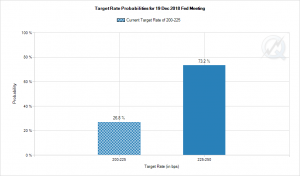Investors returned from the weekend facing the crucial Brexit vote on Tuesday and with stocks around the world hit by concerns that global trade worries will weigh further on the economy and potential auto tariffs are also clouding the world economic outlook. France is starting to slip into trouble as “yellow vests” riots and protests threaten to present uncertainty around president Macron’s future. The International Monetary Fund’s (IMF) Chief Economist Maurice Obstfeld said in an interview on Sunday, the US economic growth is likely to slowdown in the coming years.
The economists’ conviction that the European Central Bank (ECB) would raise rates in the third quarter of 2019 has faded over the last month as the probability of recession has risen, according to Reuters poll conducted Dec. 4-7.
In Tokyo the Nikkei225 ended lower by 2.12% at 21,218.50, Hang Seng index was down 1.4% and the Shanghai Composite index lower by 0.8%.
AUDUSD fell to the lowest level since early November, while AUDJPY slid to a five-week low. AUDUSD support at the 50day MA of 0.7183 was tested earlier today, and so far looks as if it may hold on the day. The moving average has supported prices on a closing basis since October 31.
GBPUSD is trading at the 4 month lows around 1.2720, according to Karen Jones, an analyst at Commerzbank, the GBPUSD pair remains above the bottom of its 4-month trading range and will find initial resistance at the 1.2840, current December high, and is likely to remain capped by the resistance line at 1.2986.
“Support at 1.2662, the August low, has been tested and held 3 times now. Below 1.2662 would trigger further weakness to the 61.8% Fibonacci retracement of the 2016-2018 advance and the June 2017 low at 1.2593/89 and below the 78.6% retracement at 1.2109.”

“Above 1.2986 lies the November 14 high at 1.3072. Further resistance comes in at the 1.3175 November high below which we will retain a longer term bearish bias.”
Euro started the week higher against US dollar as traders worry that economic growth has peaked and the Federal Reserve may pause its rate tightening cycle sooner than previously thought.
Gold rose to a six-month high of $1,251, having closed higher by 2.10 percent last week – its biggest weekly gain since March.
US yield curve inverted last week, triggering recession fears, which were bolstered by Friday’s weaker-than-expected non-farm payrolls and wage growth release. Further, China’s export growth slowed sharply in November, highlighting a weakening global demand, Meanwhile, imports growth also decelerated, indicating anemic domestic demand.
At press time, gold is trading at $1,249 just below the session high 1250.45/oz.












